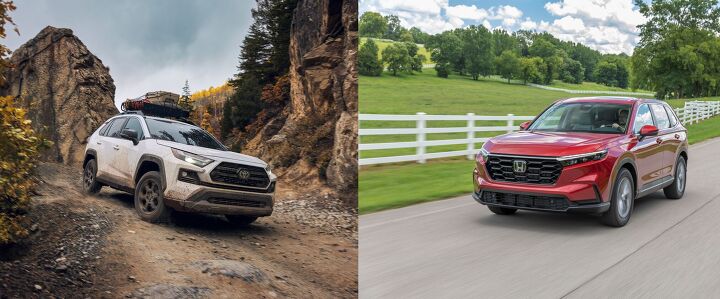Would You Rather? Honda CR-V vs Toyota RAV4

We’re introducing a new segment where we intentionally pit two vehicles against each other that are exceedingly difficult to choose between. The idea is to create a would-you-rather situation where we compare the strengths and weaknesses of both models and take input from our readers.
Our first match-up is an incredibly tough one, because these are some of the best-selling vehicles in all of North America that aren’t pickup trucks — the Honda CR-V vs the Toyota RAV4.
This sixth generation of the Honda CR-V arrived in 2023, making it quite a bit fresher than the fifth-generation of the Toyota RAV4. However, despite nearing the end of its lifecycle, the latter model has continued receiving updates and remains one of the most popular models currently on sale for North America.
With the exception of the occasional performance variant, nothing in this compact crossover segment could be considered truly engaging to drive on the open road. However, many believe the Honda shines a little brighter when it comes to on-road dynamics, braking ability, and feedback. This is likely the most apparent when going through a corner at speed, cruising on the highway, or moving through stop-and-go traffic. But perhaps not when you’re milling around pothole-laden streets or trying to hustle the car up to highway speeds.
The Honda’s non-hybrid powertrain is a turbocharged 1.5-liter inline-four with a continuously variable automatic that’s good for 190 horsepower and 179 pound-feet of torque. By contrast, Toyota’s base motor is a naturally aspirated 2.5-liter good for 203 horsepower and 184 lb-ft. Both of them are kind of buzzy at higher RPMs.
With the standard engine, each model should reach 60 mph in about 8 seconds. Truth be told, the turbo in the CR-V does make it feel a little more exciting and the continuously variable transmission (CVT) is probably the least offensive example I’ve ever encountered. But it still drones when given a lot of acceleration to cope with, making the eight-speed automatic in the RAV4 a nice alternative — even if the engine itself feels a tad more agricultural than what’s inside the Honda.
In the past, Toyota engineers have told us that they intentionally build their powertrains with longevity in mind and that under-strained motors are a large piece of the puzzle. But it doesn’t appear to have had to sacrifice much to achieve that here. In just about every trim (inducing the hybrids), the RAV4 is more efficient on the highway whereas the CR-V offers better miles per gallon around town.
However, the resulting MPG victory will typically come down to who is doing the driving. Without all-wheel drive, the Toyota nabs 27 city/35 highway whereas the Honda manages 28 mpg city/34 mpg highway. It’s a similar story with the hybrid models. Although, Toyota does offer customers the option for a plug-in RAV4 Prime variant that Honda presently lacks on our market.
While looks are highly subjective, both models have arguably gotten more handsome in their latest incarnations. The Honda is probably the design that’s most in line with modern tastes. But the Toyota is trying to come across as rugged and has retained some of the aggressive styling that we assume it’ll eventually abandon if the latest Prius and Camry are any indication.
Inside, it's the CR-V appears to have the advantage. It’s a cleaner design and looks more upscale than what you’re likely to find inside of the RAV4. That’s pretty typical of Toyota products in general. But the RAV4 is also going for an off-road vibe and happens to be a few years older than the more-recently redesigned Honda. Interior comfort is debatably better in the CR-V, with a little more space for passengers. Cargo volume is also better behind the rear seats. But the RAV4 offers more ways of storing things and has the occasional splash of color on the inside.
Both vehicles presently start just above $30,000 once you’ve factored in destination, placing them a tad higher than some of their main rivals. But the average car buyer will probably find the Honda a little more appetizing at that price point. The base Toyota simply doesn’t come with as many features off the bat, requiring you to spend a few thousand more to get into something more interesting with added features and all-wheel drive — rather than the standard front-wheel drive both crossovers come with.
A base Honda CR-V LX starts at $29,500 (before destination) and tops out around $34,660 for the EX-L trim. As a hybrid, you’ll be spending a minimum of $34,050 and maxing out at $40,200 for the premium Sport Touring Hybrid. By contrast, the Toyota RAV4 starts at $28,675 and moves up to $36,980 for the feature-rich Limited trim. Electrified options range between $31,725 for the Hybrid LE and peak at $40,030 for Hybrid Limited. The plug-in Prime version is even dearer at $43,690. But the trim allows the vehicle to drive 42 miles on all-electric power and actually makes a fairly quick crossover, with 60 mph runs taking place in about 5.5 seconds.
While the above may make the Honda CR-V look like the obvious choice if you’re not splurging on a hybrid, it might be worth considering your use case before you settle on either.
Despite both brands often being praised for their above-average reliability, the Toyota RAV4 has an extremely good reputation for longevity. The fact that the current edition has been around for a while only helps this. Furthermore, Toyota likewise has lots of off-road trims on offer that Honda doesn’t, better towing (with the correct options selected), better maximum ground clearance, and some have made the case that it’s the more capable utility vehicle overall. In hybrid guise, only the RAV4 even offers space for a spare tire and it arguably has better options for mounting rooftop luggage.
But getting the best version of the Toyota that’s capable of scrambling down some rough trails requires you spend more and none of them make the car better at running errands or tackling the daily commute. In their most basic formats, the CR-V might just be the better runabout for everyday activities.
Still, there’s this nagging voice in the back of my head warning me not to discount the RAV4. Any gaps between the two appear so incredibly narrow that personal preference and trim options should be more than sufficient to close them. We’d recommend test driving both (and probably the Mazda CX-5 or CX-50) if you're considering buying either.
Forced into making a final decision, the base Honda CR-V seems to be the best buy if you’re just looking to have a versatile vehicle with enough space for the family. But those who routinely encounter bad terrain and are willing to spend a little more by climbing the trim ladder could be better suited toward owning the Toyota RAV4. Honestly, you'd could probably flip a coin to decide between them without many regrets. Have we hit the mark or do you believe there is a clear winner in this match-up?
[Images: Honda; Toyota]
Become a TTAC insider. Get the latest news, features, TTAC takes, and everything else that gets to the truth about cars first by subscribing to our newsletter.

A staunch consumer advocate tracking industry trends and regulation. Before joining TTAC, Matt spent a decade working for marketing and research firms based in NYC. Clients included several of the world’s largest automakers, global tire brands, and aftermarket part suppliers. Dissatisfied with the corporate world and resentful of having to wear suits everyday, he pivoted to writing about cars. Since then, that man has become an ardent supporter of the right-to-repair movement, been interviewed on the auto industry by national radio broadcasts, driven more rental cars than anyone ever should, participated in amateur rallying events, and received the requisite minimum training as sanctioned by the SCCA. Handy with a wrench, Matt grew up surrounded by Detroit auto workers and managed to get a pizza delivery job before he was legally eligible. He later found himself driving box trucks through Manhattan, guaranteeing future sympathy for actual truckers. He continues to conduct research pertaining to the automotive sector as an independent contractor and has since moved back to his native Michigan, closer to where the cars are born. A contrarian, Matt claims to prefer understeer — stating that front and all-wheel drive vehicles cater best to his driving style.
More by Matt Posky
Latest Car Reviews
Read moreLatest Product Reviews
Read moreRecent Comments
- Slavuta Why is everybody sweating? Like sedans? - go buy one. Better - 2. Let CRV/RAV rust on the dealer lot. I have 3 sedans on the driveway. My neighbor - 2. Neighbors on each of our other side - 8 SUVs.
- Theflyersfan With sedans, especially, I wonder how many of those sales are to rental fleets. With the exception of the Civic and Accord, there are still rows of sedans mixed in with the RAV4s at every airport rental lot. I doubt the breakdown in sales is publicly published, so who knows... GM isn't out of the sedan business - Cadillac exists and I can't believe I'm typing this but they are actually decent - and I think they are making a huge mistake, especially if there's an extended oil price hike (cough...Iran...cough) and people want smaller and hybrids. But if one is only tied to the quarterly shareholder reports and not trends and the big picture, bad decisions like this get made.
- Wjtinfwb Not proud of what Stellantis is rolling out?
- Wjtinfwb Absolutely. But not incredibly high-tech, AWD, mega performance sedans with amazing styling and outrageous price tags. GM needs a new Impala and LeSabre. 6 passenger, comfortable, conservative, dead nuts reliable and inexpensive enough for a family guy making 70k a year or less to be able to afford. Ford should bring back the Fusion, modernized, maybe a bit bigger and give us that Hybrid option again. An updated Taurus, harkening back to the Gen 1 and updated version that easily hold 6, offer a huge trunk, elevated handling and ride and modest power that offers great fuel economy. Like the GM have a version that a working mom can afford. The last decade car makers have focused on building cars that American's want, but eliminated what they need. When a Ford Escape of Chevy Blazer can be optioned up to 50k, you've lost the plot.
- Willie If both nations were actually free market economies I would be totally opposed. The US is closer to being one, but China does a lot to prop up the sectors they want to dominate allowing them to sell WAY below cost, functionally dumping their goods in our market to destroy competition. I have seen this in my area recently with shrimp farmed by Chinese comglomerates being sold super cheap to push local producers (who have to live at US prices and obey US laws) out of business.China also has VERY lax safety and environmental laws which reduce costs greatly. It isn't an equal playing field, they don't play fair.











































Comments
Join the conversation
The simple fact that the Honda has a CVT & the Toyota doesn't was more than enough for me to pick the Toyota for both of my daughters.
The RAV4, and I say this as someone who currently owns a 2014 CR-V. My aunt has a 2018 CR-V that has had a lot of electrical issues, and I don't trust the turbo and CVT to last as long as Toyota's NA engine and 8-speed automatic. Plus, the RAV4 looks sportier and doesn't have the huge front overhang.